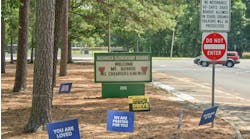Graduation is a proud moment for students and their families. But as everyone is counting down the final days, commencement and convocation professionals, the official planners of these events, are putting the final touches on the details to make the day a seamless success.
Some critical areas need attention to keep guests safe and reduce liability on graduation day:
•Make sure all contracts are signed and filed. Paperwork is critical for a successful ceremony. Contracts should spell out every detail of what has been agreed to (e.g., who is responsible for setup, hours when certain events will happen, when the facility must be vacated, who is responsible for renting specific gear). Oral agreements, especially with off-campus venues, are not valid. Often, trustees designate only a handful of people to contract on behalf of the institution, and all contracts have to be signed by those individuals. Persons who sign contracts without authority could be personally liable.
If a university is having tents at a ceremony, schools may need a dig permit that requires an inspection of the property so that underground fiber-optic cables, gas and cable TV lines can be avoided. When a school contracts for food services, whether indoors or outdoors, food vendors need health-department approval.
•Assess all potential threats. Typically, commencement and convocation professionals work with their campus-safety personnel, who then interface with local law enforcement. Threats may range from weather to terrorists to groups advocating certain points of view. When institutions have high-profile speakers at graduation ceremonies, it’s important to know their supporters and adversaries. Monitor the weather and have an emergency plan in place.
•Develop a comprehensive emergency plan. An emergency plan should define procedures, the persons who have the authority to make decisions and how these decisions will be carried out. It should include protocol for every detail of the ceremony and be part of a larger regional plan developed with local law enforcement and emergency managers.
•Rehearse emergency plans. Make sure the staff is certified in first aid and that everyone knows the location of defibrillators. Take into consideration people with special needs. Establish a plan in case you need to get them out and determine who is responsible.
Evacuation doesn’t mean just leaving a building. It could be leaving a field or stadium. This protocol should be included in the emergency plan. Medical personnel also should be consulted ahead of time for cases of people becoming ill or injured. Always have emergency personnel on site.
•Coordinate traffic and parking. Meet with campus safety or municipal police to set expectations for the day of the ceremony (e.g., how many people are expected, do streets need to be blocked off or opened, who is directing traffic, whether extra security is needed). Learn what other activities are happening in the area during the day of the ceremony to help alleviate congestion.
Institutions offering satellite parking should make sure shuttle buses can accommodate guests with disabilities. Routes need to be planned out and parking marked.
Harris is associate vice president for advancement at the University of Alabama—Huntsville, responsible for ceremonies, public events and university protocol. She is past president of the North American Association of Commencement Officers (NAACO).

